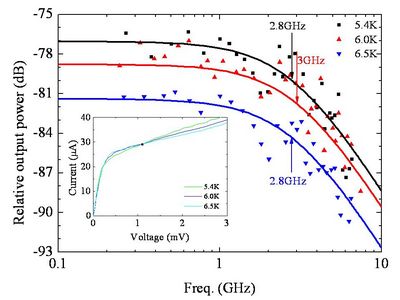
(Image by ZHANG Wen)
Fig. 1 Measured gain bandwidth at the same DC bias point but different bath temperatures. Bath temperatures are 5.4, 6 and 6.4 K, respectively. The inset shows the I-V curves at different bath temperatures, intersection point of which is the DC bias point for gain bandwidth measurement.
Researchers led by Prof. SHI Shengcai , Purple Mountain Observatory, Chinese Academy of Sciences, combine heterodyne mixing with direct detection of superconducting hot electron bolometer, which is based on a several nanometer thick NbN film, connected to a planar antenna. The superconducting hot electron bolometer was assumed to have high sensitivity at a bath temperature far below its transition temperature. For some special applications, for example, Dome A 5m THz telescope in Antarctica and space missions, less cooling requirement is desirable, making heterodyne mixer operating at higher temperature. Superconducting NbN HEB can also be used to directly detect week signal in the vicinity of superconducting transition as a detector due to its sharp temperature dependence of resistance.
They studied the receiver noise temperature and intermediate frequency gain bandwidth at different bath temperatures, and find that the corrected noise temperature and IF gain bandwidth are 800 K at 0.5THzand 750 K 0.85 THz, and 3 GHz at its optimum bias point. Both the receiver noise temperature and IF gain bandwidth were found insensitive to the bath temperature, in good agreement with those simulated with the hot-spot model taking account of the HEB’s current-dependent resistive transition. Furthermore, the HEB’s frequency response was measured by a Fourier transform spectrometer at different bias points and bath temperatures. The estimated noise equivalent power (NEP) was close to 10-13 W/Hz0.5 around the HEB’s transition temperature. The work by ZHANG Wen, MIAO W., ZHOU K. M. , LI S. L. , LIN Z. H. , YAO Q. J. , and SHI S.C. (corresponding author), accepted by IEEE transactions on applied superconductivity, has been published online ( http://ieeexplore.ieee.org/xpl/freeabs_all.jsp?arnumber=5685588 ).




